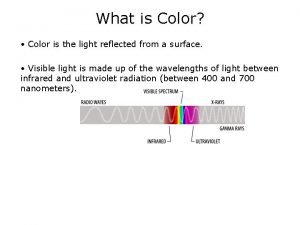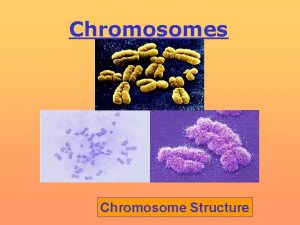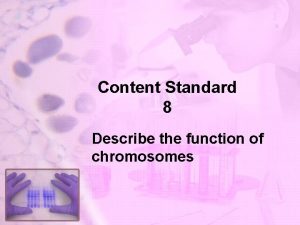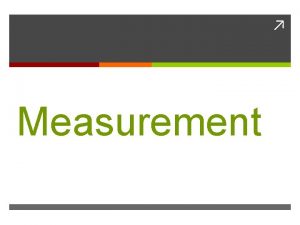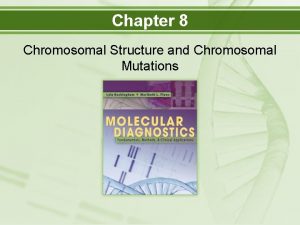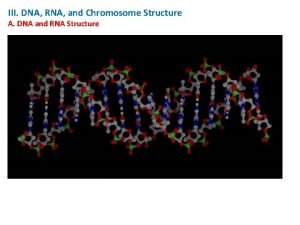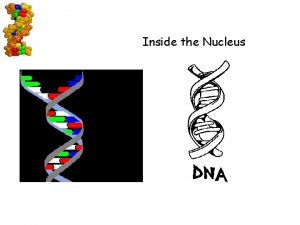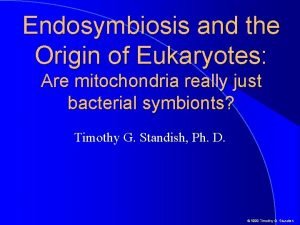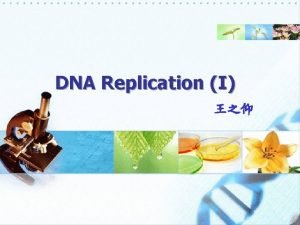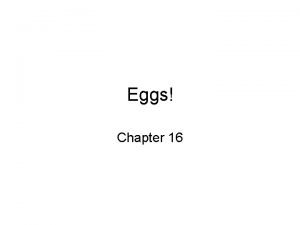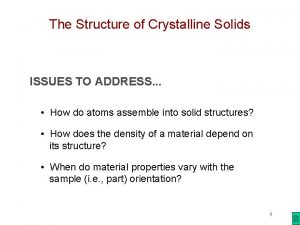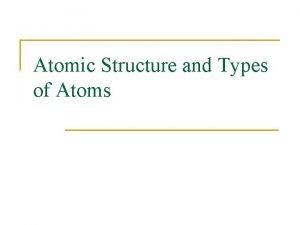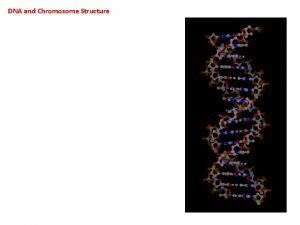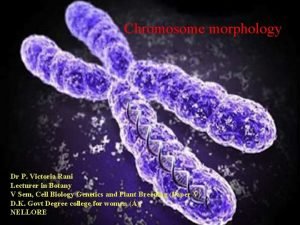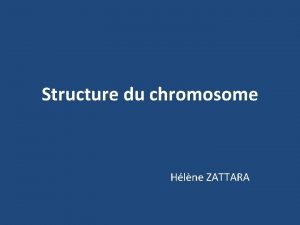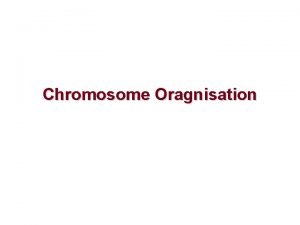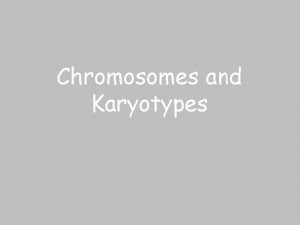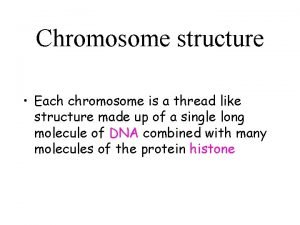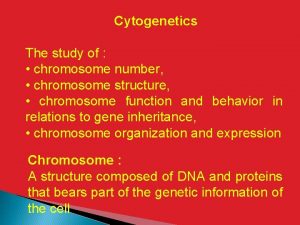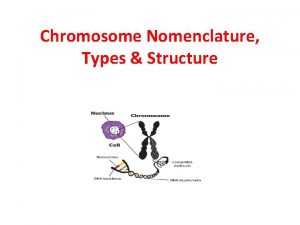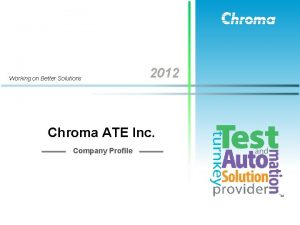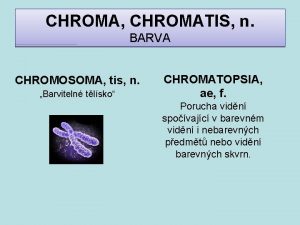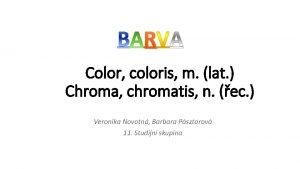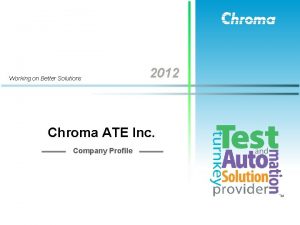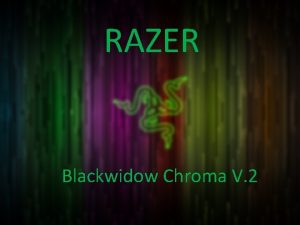Chromosome and its Structure Chromosome Chromosome means chroma


































- Slides: 34

Chromosome and its Structure

Chromosome • Chromosome means: chroma - colour; some body) • E. Strasburger in 1875 discovered thread-like structures which appeared during cell division • Waldeyer coined the term chromosome first time in 1888. • In all types of higher organisms (eukaryote), the well organized nucleus contains definite number of chromosomes of definite size, and shape.

• A chromosome is a thread-like selfreplicating genetic structure containing organized DNA molecule package found in the nucleus of the cell



• Chromosomes are seen during metaphase stage of mitosis when the cells are stained with suitable basic dye and viewed under light microscope.


• The somatic chromosome number is the number of chromosomes found in somatic cell and is represented by 2 n (Diploid) • The gametic chromosome number is half of the somatic chromosome numbers and represented by n (Haploid) • The two copies of chromosome are ordinarily identical in morphology, gene content and gene order, they are known as homologus chromosomes.

• Chromosomes are of two types – Autosomes: that control characters other than sex characters or carry genes for somatic characters. – chromosomes (Gonosomes) – Chromosomes involved in sex determination

• Humans and most other mammals have two sex chromosomes X & Y, also called heterosome • Females have two X chromosomes in diploid cells; males have an X and a Y chromosome • In birds the female (ZW) is hetero-gametic and male (ZZ) is homo-gametic

Diploid and Haploid chromosome number • Diploid cells (2 N where N- chromosome number) have two homologous copies of each chromosome • The body cells of animals are diploid • Haploid cells (N) have only one copy of each chromosome • In animals, gametes (sperm and eggs) are haploid

• Chromosome number varies from 2 n = 4 (n = 2) to 2 n = > 1200. (n = gametic or haploid chromosome number 2 n = somatic or diploid chromosome number) • The number of chromosomes varies from species to species • Normally all individual of a species have the same chromosome number



• The size of chromosome is normally measured at mitotic metaphase and may be as short as 0. 25 µm in fungi and birds, or as long as 30 µm in some plants like Trillium • Each chromosome has two arms - p (the shorter of the two) and q (the longer).

• Chromosome shape is usually observed at anaphase, when the position of primary constriction (centromere) determines chromosome shape • This constriction or centromere can be terminal, sub-terminal or median in position.

• Homologous Chromosomes • Diploid organisms have two copies of each chromosome (except the sex chromosomes) • Both the copies are ordinarily identical in morphology, gene content and gene order and hence known as homologous chromosomes.

• Each pair of chromosomes made up of two homologs • Homologous chromosome is inherited from separate parents; one homolog comes from the mother and the other comes from the father.

Special Types of Chromosomes: Polytene Chromosomes • It was discovered by Balbiani (1881) and named by Koller • The nuclei of the salivary gland cells of the larvae of dipterans like Drosophila have unusually long and wide chromosomes, 100 or 200 times in size of the chromosomes in meiosis and mitosis of the same species


• Salivary gland cells do not divide after the glands are formed, yet their chromosomes replicate several times (a process called endomitosis) and become exceptionally giantsized

• The giant chromosomes consist of a bundle of chromosomal fibrils which arise by a series of about 10 consecutive duplications of the initial chromonemata that increase the DNA content about 1000 times than the DNA content of somatic cells

• The endomitosis process result in the production of 2 X chromosomes, where X gives the number of multiplication cycle • Because of the multi-stranded condition, these chromosomes are called polytene chromosomes

• The polytene chromosomes bear along their entire length a series of dark bands alternated by light bands or inter-bands • The dark bands are narrow or broad disc shaped structures • They are euchromatic in nature and contain large amount of DNA, small amount of RNA and certain basic proteins

• The light bands or interbands are fibrillar, heterochromatic regions containing small amount of DNA and large amount of RNA and acidic proteins • They have alternating dark and light bands • The dark bands are disc-shaped structures occupying the whole diameter of chromosomes and it contains euchromatin • The light bands are fibrillar and composed of heterochromatin

• During certain developmental stages, the single bands or adjacent bands of polytene chromosomes produce local reversible swellings which are called ‘chromosomes puffs’ or bulbs • The chromonemata of polytenic chromosomes give out many series of loops laterally • These loops or rings are known as the balbiani rings and they are rich in DNA and RNA

Lampbrush Chromosome • Lampbrush chromosomes are special type of giant chromosomes found in the nuclei of oocytes of many vertebrates, such as fishes, amphibians, reptiles and birds • It was first observed by Flemming in 1882 and given the name by Ruckert in 1892 • Formed during the diplotene stage in the nuclei of oocytes during the active synthesis of m. RNA molecules for the future use


• These chromosomes may sometime become even larger than the polynemic or polytenic chromosomes of salivery glands of dipterans • The largest chromosomes may sometime be as long as 1 mm in urodele amphibians.

• These chromosomes consist of main axis and many fine lateral projections or loops which give them the appearance of a test tube brush or lampbrush • Physiological studies indicate that the loops of lamp-brush chromosomes and balbiani rings of polytene chromosomes are the sites of active genes

B Chromosomes • Many organisms have a special chromosome in addition to the autosomes which are called B chromosomes • Also termed as supernumery or accessary chromosomes or accessory fragments • Smaller that autosomes and the number varies from 0 to 30/ cell


• In some animals they may be derivatives of sex chromosomes • May have negative effects on the cell

Holokinetic Chromosomes • In insects of the order Hemiptera and in some monocotyledonous plants the kinetic acitivity is distributed over the entire chromosome • The term diffuse centromere has been used as an alternative • In 1966 Flach observed this type of centromere in some primitive Dicotyledons along with pseudoscorpion and Ascaris
 Chroma hue value
Chroma hue value Chroma soil
Chroma soil Vertical edge
Vertical edge How to read chromosome
How to read chromosome Which chromosome
Which chromosome Quadrilateral pentagon hexagon octagon
Quadrilateral pentagon hexagon octagon Meta and morph means
Meta and morph means Meaning of biodiversity conservation
Meaning of biodiversity conservation Meta means in metamorphism
Meta means in metamorphism Emigree poem analysis
Emigree poem analysis Its halloween its halloween the moon is full and bright
Its halloween its halloween the moon is full and bright Bio means 'life
Bio means 'life Shall i compare thee to a summer's day meter
Shall i compare thee to a summer's day meter Its fine means
Its fine means Its monday you know what that means
Its monday you know what that means When a train increases its velocity its momentum
When a train increases its velocity its momentum Windy cloudy rainy sunny
Windy cloudy rainy sunny If its a square it's a sonnet summary
If its a square it's a sonnet summary Its not easy but its worth it
Its not easy but its worth it Alterations of chromosome structure
Alterations of chromosome structure Structure of chromosome
Structure of chromosome Structure of a chromosome
Structure of a chromosome Chromosome diagram
Chromosome diagram Telophase
Telophase Ribosome
Ribosome Eukaryotic chromosome structure
Eukaryotic chromosome structure Eukaryotic chromosome structure
Eukaryotic chromosome structure Label structure of an egg
Label structure of an egg Word structure
Word structure Packing fraction of bcc
Packing fraction of bcc Atom and its structure
Atom and its structure Niels bohr atomic model
Niels bohr atomic model Atom and its structure
Atom and its structure Atom and its structure
Atom and its structure Aaron clauset
Aaron clauset
